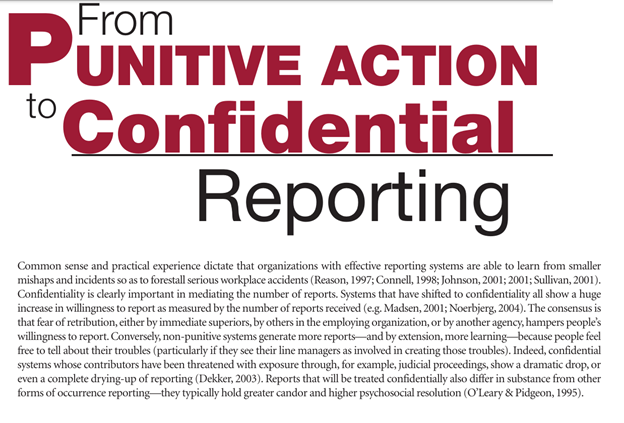
This study explored the shift from a punitive to non-punitive reporting approach in a hospital over 2 years, while assessing the capacity and success of learning.
Before the transition, an employee involved in an incident reported the event to his/her manager, who would then devise improvements (mostly in the form of a reminder to watch out, extra coaching, retraining). Employees were compelled to report on their own safety performance, since they knew other people would report them if discovered.
After the transition, employees could bypass their line manager and report the incident to a newly revamped safety staff, who would try to extract broader learning leverage.
Providing background:
· They argue that “Confidentiality is clearly important in mediating the number of reports”
· Systems that have shifted to a confidentiality approach have shown large increases in willingness to report
· Not surprisingly, “fear of retribution, either by immediate superiors, by others in the employing organization, or by another agency, hampers people’s willingness to report”
· Non-punitive approaches led to more learning opportunities because people feel free to discuss their troubles
· Interestingly, the effects of reporting systems on learning isn’t well clarified. One study that reviewing 58 studies on safety interventions “were forced to conclude that the effects on organizational learning were so confounded as to turn out virtually undemonstrable”
· In very safe systems, the “statistical baseline of incidents (let alone accidents) is so low, that numerical demonstrations of learning (by counting fewer serious events) are impossible, too”
· Confidential reporting systems and the resultant “Stories of individual encounters with risk”, can represent a powerful vehicle for vicarious learning, if distributed back into the community
· This study sought to understand whether the lack of retribution is the chief factor that inhibits higher reporting
· This organisation had “run up against the limits of the so-called blame cycle … Incidents had been seen as a result of human error, triggering reprimands and extra training for individuals”
· Moreover, while the organisation “thought it was doing what it could, the incident count did not go down”
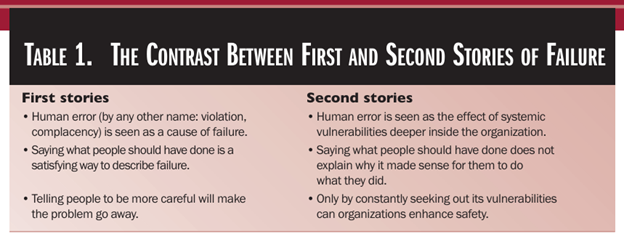
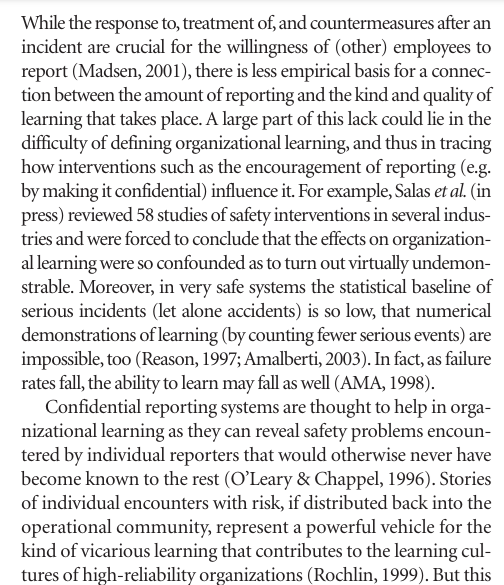
Results
Based on these findings, they assert that:
· “Taken at face value, findings confirm that fear of retribution hampers safety reporting”
· When the organisation shifted from line-management-based evaluations of reports to a more confidential approach where safety staff deal with reports, the numbers went up
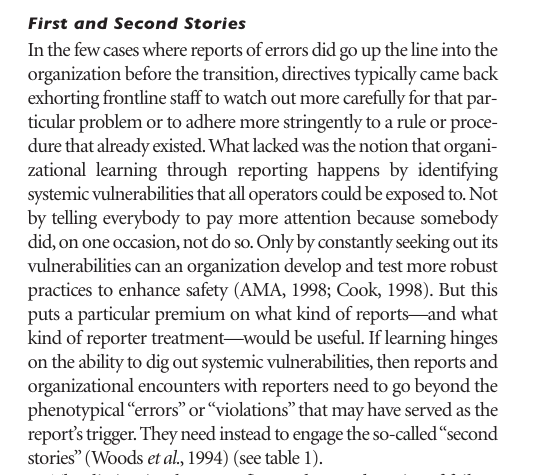
Interestingly, before the transition, employees were actually “ready to confess” their errors to line managers; where it was “almost seen as an act of honor”.
That is, people did report their own errors and violations because this led to a rapid closure for all involved. Management wouldn’t have to dig deeper, as the employee “had seen the error of his or her ways and had been reprimanded and told or trained to watch out better next time”.
For employees, reporting their errors was a simple and quick way to avoid even more and deeper questions, and could even “help avert career consequences”.
Hence, the fear of retribution didn’t necessary discourage reporting but “encouraged a particular kind of reporting: a mea culpa with minimal disclosure that would get it over with quickly for everybody”. Moreover, ‘human error’ seemed to benefit everybody, except learning.
First and Second Stories
Before the transition, there lacked a notion that organisational learning happens via identifying systemic vulnerabilities that all operators could be exposed to. But a revised approach focused on learning and improving systemic vulnerabilities “puts a particular premium on what kind of reports—and what kind of reporter treatment—would be useful”.
That is, if learning hinges on digging out systemic vulnerabilities, then reports need to go beyond “phenotypical ‘errors’ or ‘violations’ that may have served as the report’s trigger”. Rather, they need to move to second stories.
First stories reflect a more simplified story of reality, where the event could have been averted if people paid more attention. These fall back on error as explanations and stop there, leaving people and organisations wondering “how they can possibly cope with the unreliability of the human element in their midst”.
Instead, second stories construct different attributions and found out why things go wrong. They reveal conflicting goals, pressures and systemic vulnerabilities behind the ‘error’; where ‘error’ is a starting point, not a conclusion.
They argue that recognising the need for second stories and systems vulnerabilities “is a precondition for making organizational investments to cope with the real sources of risk: the genotypical contributors to failure”
Whereas before the transition sometimes safety improvements were aimed at removing the bad apples “who contaminated or undermined an otherwise safe system”, these types of responses were rare after the transition.
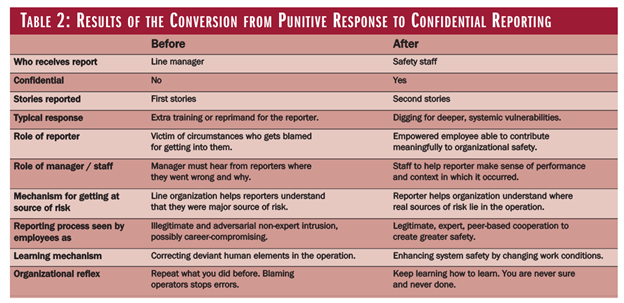
Safety Reports and Levers for Learning
After the transition, reports typically contained more contributing factors, and shed counterfactual language, like “the operator should have…”. Instead, the report probed the reasons why it made sense for operators to do what they did.
Also, the “Simple causal statements gradually made way for more complex etiologies that could taken an entire paragraph”.
Getting to the second stories is a precondition for finding the leverage points for learning and making systemic changes. This requires a bunch of changes and doesn’t guarantee organisational learning, but it does represent a precondition for learning.
Employee Empowerment
Employee empowerment was also an evident theme based on interviews resulting from the shift; from those managers with a “distant view of real practice”, to the safety staff and then operators “closely connected to the actual nature of work”.
Ensuring operators had the opportunity to actively contribute in the process was found to be motivating. Indeed, the study found that “the chief reason why operators’ willingness to report went up was not the lack of retribution, but rather the realization that they could “make a difference.”
Involving them gave them ownership.
Raising Awareness
Prior to the transition, organisational learning was said to be primarily conceptualised as frequent reminders and reprimands with the “top-down dispensing of awareness about a problem”.
They suggest that reminders can actually have a desired impact though, but “only under near-perfect
Circumstances”. More usefully, awareness should be raised by a peer, somebody who “has legitimacy and knowledge to speak about the issue” and it should be specific enough for the target to recognise the relevancy.
Conclusion
In all, they argue that their results don’t contradict the “basic wisdom” of confidential reporting. Instead, these findings expand the understanding that it’s hinged less on a lack of fear of retribution but more a complex relationship.
That is, people weren’t necessarily afraid to report, but actually reported as an easy way to “get off the hook”.
They suggest the rather obvious approach of facilitating a feeling of empowerment, non-punitive approach, with ownership and a stake in the results.
Offering people the “ability to construct second, deeper stories of the incident appears to be a basic precondition to help organizations learn and improve”.
Learning is said to be about constantly monitoring whether those abilities to adapt, resilient capacities, are still present. This involves “calibrating the organization’s models of risk—are they still up to date?”.
This study found that the organisation’s model of risk, being “unreliable people in anotherwise safe system” was obsolete or not returning any valuable lessons.
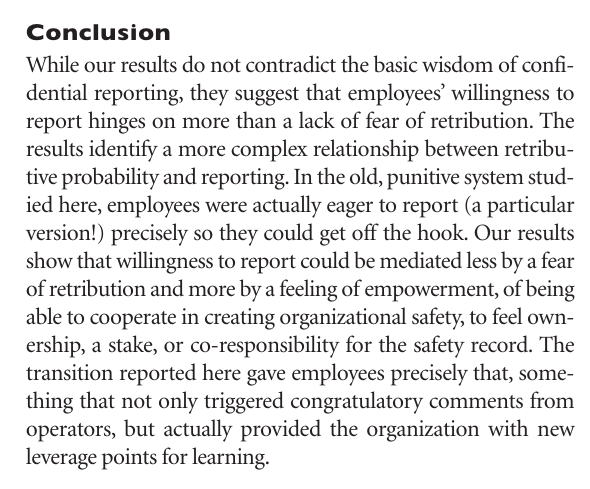
Authors: Dekker, S. W. A., & Laursen, T. (2007). From punitive action to confidential reporting: A longitudinal study of organizational learning. Patient Safety & Quality Healthcare, 5, 50-56.
My site with more reviews: https://safety177496371.wordpress.com
LinkedIn post: https://www.linkedin.com/pulse/from-punitive-action-confidential-reporting-study-ben-hutchinson-jlowe
One thought on “From punitive action to confidential reporting: A longitudinal study of organizational learning”